Site and Formation Selection for CO2 Geological Sequestration: Research Progress and Case Analyses
Abstract
1. Introduction
2. The History of Global CO2 Geological Sequestration Development
3. Projects in Europe and Africa
3.1. Norway Sleipner Project
3.2. The Norwegian Snøhvit Project
3.3. German Ketzin Project
3.4. Iceland CarbFix Project
3.5. Algerian in Salah Project
4. Asia–Pacific Region
4.1. Australian Gorgon Project
4.2. Chinese Shenhua Project
4.3. Chinese Enping 15-1 Project
4.4. Japanese Tomakomai Project
4.5. Japanese Nagaoka Project
5. Projects in the Americas
5.1. Canadian Quest Project
5.2. American Decatur Project
5.3. American Wallula Project
5.4. Brazilian Pre-Salt Project
5.5. American SACROC Project
6. Global Development Recommendations for CO2 Geological Sequestration Technology
6.1. Engineering Challenges Faced by CCS Technology Development
- (1)
- Complexity and Uncertainty in Sequestration Site Selection
- (2)
- Limitations of Long-Term Sequestration Monitoring
- (3)
- Difficulties in Injection and Site Parameter Design
- (4)
- Difficulties in Large-Scale Layout and Full Industrial Chain Development
6.2. Development Recommendations for CCS Technology
- (1)
- Establish a Multi-Level, Quantitative Site Selection Evaluation System and Clarify Quantitative Thresholds for Key Geological Parameters
- (2)
- Build a Comprehensive and Multi-Dimensional Monitoring System to Effectively Identify and Assess CO2 Leakage Risks
- (3)
- Strengthen the Collaborative Optimization of Engineering Parameters for CCS Projects
6.3. Development Prospects for CCS Technology
- (1)
- The coupling process of physical geostress–temperature–formation properties should be studied, considering the multi-scale effects of mineral dissolution, precipitation, pore pressure evolution, and changes in rock mass mechanical properties. In this way, multi-field coupling models suitable for different geological sequestration scenarios can be established.
- (2)
- Through the integration of long-term laboratory physical simulation and field monitoring data, the temporal variation laws of formation porosity, permeability and mechanical strength during the long-term sequestration process should be quantified, improving the parameter calibration method for the site and formation selection model.
- (3)
- A risk assessment algorithm based on the multi-field coupling model should be developed to accurately identify potential risk areas (e.g., structurally active zones) during the site and reservoir screening phase. In this way, theoretical support could be provided for safety assessment, risk prediction, and sequestration site emergency prevention and control.
7. Conclusions
Author Contributions
Funding
Institutional Review Board Statement
Informed Consent Statement
Data Availability Statement
Conflicts of Interest
References
- Gao, Q.H.; Qin, Y.Y.; Liang, M.C.; Gao, X. Interpretation of the Main Conclusions and Suggestions of IPCC AR6 Synthesis Report. Environ. Prot. 2023, 51, 82–84. [Google Scholar]
- Cai, Z.Y.; You, Q.L.; Wu, F.Y.; Jiang, Z.H.; Zhai, P.M. China’s climate and extreme climate changes under the global carbon neutrality scenario. Sci. Technol. Rev. 2024, 42, 73–84. [Google Scholar]
- International Energy Agency. Global Energy Review 2025; International Energy Agency: Paris, France, 2025. [Google Scholar]
- IEA. CO2 Emissions in 2023; International Energy Agency: Paris, France, 2024. [Google Scholar]
- Wang, W.B.; Ni, J.; Li, C.N.; Wang, M.; Kang, X.Y.; Feng, Z.; Wang, C.J.; Cui, K.; Lu, Q.C. Technical path and practice of green enhanced oil recovery under “dual carbon” target. Appl. Chem. Ind. 2024, 53, 1497–1503. [Google Scholar]
- Wang, Y.H. Challenges and Suggestions for China′s Energy Transition. Sino-Glob. Energy 2022, 27, 10–16. [Google Scholar]
- Niu, F.F.; Su, E.L.; Wei, J.Q.; Zhu, X.Y. Effect of supercritical CO2 on pore structure and desorption characteristics of tectonic coal. Saf. Coal Mines 2025, 56, 27–32. [Google Scholar]
- Mou, Y.; Wang, H.F.; Lai, X.J.; Ma, J.F.; Luo, S.C.; Li, L.; Ding, Z. Assessment indicator system for siting of geologic CO2 sequestration in low-porosity and low-permeability saline aquifers: A case study of the Ordos Basin. Coal Geol. Explor. 2025, 53, 99–112. [Google Scholar]
- Jiang, L.T.; Ma, T.R.; Li, C.; Guo, C.B.; He, Q.C.; Ma, X.D.; Zhang, S.Z. The modeling and numerical study of fault activation and fluid leakage in CO2 geological storage. Acta Geol. Sin. 2024, 98, 3418–3432. [Google Scholar]
- Zhang, S.; Jiang, S.; Li, H.; Li, P.R.; Zhong, X.P.; Chen, C.; Tu, G.G.; Liu, X.; Xu, Z.H. Current Status and Reflections on Ocean CO2 Sequestration: A Review. Energies 2025, 18, 942. [Google Scholar] [CrossRef]
- Balat, H.; Öz, C. Technical and Economic Aspects of Carbon Capture an Storage—A Review. Energy Explor. Exploit. 2007, 25, 357–392. [Google Scholar] [CrossRef]
- Han, S.W.; McPherson, J.B.; Lichtner, C.P.; Wang, F.P. Evaluation Of Trapping Mechanisms In Geologic CO2 Sequestration: Case Study Of Sacroc Northern Platform, a 35-year CO2 injection site. Am. J. Sci. 2010, 310, 282–324. [Google Scholar] [CrossRef]
- Smyth, R.C.; Hovorka, S.D.; Lu, J.; Romanak, K.D.; Partin, J.W.; Wong, C.; Yang, C.B. Assessing risk to fresh water resources from long term CO2 injection–laboratory and field studies. Energy Procedia 2009, 1, 1957–1964. [Google Scholar] [CrossRef]
- Gan, M.G.; Zhang, L.W.; Li, X.C.; Li, Q.; Lu, S.J. Development status of CCUS technology in Europe and the enlightenment to China. Therm. Power Gener. 2023, 52, 1–13. [Google Scholar]
- Luo, P.; Er, V.; Freitag, N.; Huang, S. Recharacterizing evolving fluid and PVT properties of Weyburn oil–CO2 system. Int. J. Greenh. Gas Control 2013, 16, S1, S226–S235. [Google Scholar] [CrossRef]
- Li, J.; Weng, L.; Zhao, X.L.; Guo, Y.; Li, X. CO2 leakage prediction of Shenhua Erdos CCS site. Chem. Eng. 2015, 43, 11–15. [Google Scholar]
- Ma, X.R.; Liang, J.; Li, Q.; Chen, J.W.; Yuan, Y.; Luo, D.; Zhao, H.L. Study of CO2 mineralization and storage mechanism in basalt and sandstone. Mar. Geol. Front. 2025, 41, 56–64. [Google Scholar]
- Gao, Z.H.; Xia, C.Y.; Liao, S.L.; Yu, X.J.; Liu, M.X.; Li, P.C.; Liang, X.; Dai, Q.; Huang, X.W. Progress of Methods for Assessing CO2 Mineralization Storage Potential in Basalt. Geol. J. Chin. Univ. 2023, 29, 66–75. [Google Scholar]
- Falcon-Suarez, I.; Papageorgiou, G.; Chadwick, A.; North, L.; Best, A.I.; Chapman, M. CO2-brine flow-through on an Utsira Sand core sample: Experimental and modelling. Implications for the Sleipner storage field. Int. J. Greenh. Gas Control 2018, 68, 236–246. [Google Scholar] [CrossRef]
- Zhang, G.; Lu, P.; Zhu, C. Model predictions via history matching of CO2 plume migration at the Sleipner Project, Norwegian North Sea. In Proceedings of the International Conference on Greenhouse Gas Control Technologies, Austin, TX, USA, 5–9 October 2014. [Google Scholar]
- Zhou, Y.B.; Wang, R.; He, Y.F.; Zhao, S.X.; Zhou, Y.L.; Zhang, Y. Analysis and comparison of typical cases of CO2 geological storage in saline aquifer. Pet. Geol. Recovery Eff. 2023, 30, 162–167. [Google Scholar]
- Ping, L.; Wang, H.; Tian, Y.; Zhang, H.L.; Wu, X.P.; Chen, S.H.; Liu, Y.H.; Liu, Y.Z.; Liu, S.Q.; Sang, S.X.; et al. Typical Case Studies and Classification with Evaluation of Carbon Dioxide Geological Sequestration in Saline Aquifers. Processes 2024, 12, 2562. [Google Scholar] [CrossRef]
- Jing, J.; Yuan, Y.L.; Yang, Y.L.; Wang, F.G.; Yang, Z.J. Influence of strata dip on CO2 geological storage—A case study of Erdos CCS project. Geotech. Investig. Survey 2014, 42, 39–44. [Google Scholar]
- Sun, L.; Chen, W.Y. A Review of Selection Criteria for the Geological Sequestration of CO2. Ecol. Econ. 2012, 7, 33–38. [Google Scholar]
- Michael, K.; Golab, A.; Shulakova, V.; Ennis-King, J.; Allinson, G.; Sharma, S.; Aiken, T. Geological storage of CO2 in saline aquifers-A review of the experience from existing storage operations. Int. J. Greenh. Gas Control 2010, 4, 659–667. [Google Scholar] [CrossRef]
- Fornel, A.; Estublier, A. To A Dynamic Update of the Sleipner CO2 Storage Geological Model Using 4D Seismic Data. Energy Procedia 2013, 37, 4902–4909. [Google Scholar] [CrossRef]
- Zhou, Y.B.; Wang, R.; Zhao, S.X.; He, Y.F. “Fit to purpose” geological modeling methods and cases in the process of CO2 storage. Unconv. Oil Gas 2022, 9, 1–8. [Google Scholar]
- Karstens, J.; Ahmed, W.; Berndt, C.; Class, H. Focused fluid flow and the sub-seabed storage of CO2: Evaluating the leakage potential of seismic chimney structures for the Sleipner CO2 storage operation. Mar. Pet. Geol. 2017, 88, 81–93. [Google Scholar] [CrossRef]
- Pruess, K. Modeling CO2 leakage scenarios, including transitions between super and sub-critical conditions, and phase change between liquid and gaseous CO2. Energy Procedia 2011, 4, 3754–3761. [Google Scholar] [CrossRef]
- Lian, W.; Wang, N.H.; Li, J.; Li, Q.X. Research Progress on CO2 Geological Storage Leakage Mechanism and Wellbore Integrity. J. South China Norm. Univ. (Nat. Sci. Ed.) 2024, 56, 1–15. [Google Scholar]
- Oldenburg, M.C. Joule-Thomson cooling due to CO2 injection into natural gas reservoirs. Energy Convers. Manag. 2007, 48, 1808–1815. [Google Scholar] [CrossRef]
- Bruno, S.M.; Lao, K.; Diessl, J.; Childers, B.; Xiang, J.; White, N.; van der Veer, E. Development of Improved caprock Integrity Analysis and Risk Assessment Techniques. Energy Procedia 2014, 63, 4708–4744. [Google Scholar] [CrossRef]
- Bateman, K.; Rochelle, C.; Purser, G.; Kemp, S.J.; Wagner, D. Geochemical Interactions Between CO2 and Minerals within the Utsira Caprock: A 5-year Experimental Study. Energy Procedia 2013, 37, 5307–5314. [Google Scholar] [CrossRef]
- Hansen, O.; Gilding, D.; Nazarian, B.; Osdal, B.; Ringrose, P.; Kristoffersen, J.B.; Eiken, O.; Hansen, H. Snøhvit: The history of injecting and storing 1 Mt CO2 in the fluvial Tubåen Fm. Energy Procedia 2013, 37, 3565–3573. [Google Scholar] [CrossRef]
- Hansen, O.; Eiken, O.; Stmo, S.; Johansen, R.I.; Smith, A. Monitoring CO2 Injection into a Fluvial Brine-filled Sandstone Formation At the Snhvit Field, Barents Sea. In Proceedings of the 2011 SEG Annual Meeting, San Antonio, TX, USA, 18–23 September 2011. [Google Scholar]
- Chiaramonte, L.; White, J.A.; Trainor-Guitton, W. Probabilistic geomechanical analysis of compartmentalization at the Snøhvit CO2 sequestration project. J. Geophys. Res. Solid Earth 2015, 120, 1195–1209. [Google Scholar] [CrossRef]
- Deng, X.B. Reservoir Interlayer Features of Section J1s2 in Block Zhong 1 of Junggar Basin. Sci. Technol. Eng. 2016, 16, 27–31. [Google Scholar]
- Abitkazy, T.; Yan, L.; Albriki, K.; Baletabieke, B.; Yuan, D.W.; He, Y.F.; Sarbayev, A. Comprehensive Characterization and Impact Analysis of Interlayers on CO2 Flooding in Low-Permeability Sandstone Reservoirs. Energies 2025, 18, 593. [Google Scholar] [CrossRef]
- Shi, J.Q.; Imrie, C.; Sinayuc, C.; Durucan, S.; Korre, A.; Eiken, O. Snhvit CO2 Storage Project: Assessment of CO2 Injection Performance Through History Matching of the Injection Well Pressure Over a 32-months Period. Energy Procedia 2013, 37, 3267–3274. [Google Scholar] [CrossRef]
- Ringrose, S.P. The CCS hub in Norway: Some insights from 22 years of saline aquifer storage. Energy Procedia 2018, 146, 166–172. [Google Scholar] [CrossRef]
- Martens, S.; Kempka, T.; Liebscher, A. Field experiment on CO2 back-production at the Ketzin pilot site. In Proceedings of the European Geosciences Union General Assembly, Vienna, Austria, 12–17 April 2015. [Google Scholar]
- Ouellet, A.; Bérard, T.; Desroches, J.; Frykman, P.; Welsh, P.; Minton, J.; Pamukcu, Y.; Hurter, S.; Schmidt-Hattenberg, W. Reservoir geomechanics for assessing containment in CO2 storage: A case study at Ketzin, Germany. Energy Procedia 2010, 4, 3298–3305. [Google Scholar] [CrossRef]
- Bergmann, P.; Ivandic, M.; Norden, B.; Ruecker, C.; Kiessling, D.; Lueth, S.; Schmide-Hattenberger, C.; Juhlin, C. Combination of seismic reflection and constrained resistivity inversion with an application to 4D imaging of the CO2 storage site, Ketzin, Germany. Geophysics 2014, 79, B37–B50. [Google Scholar] [CrossRef]
- Bergmann, P.; Diersch, M.; Götz, J.; Ivandic, M.; Ivanova, A.; Juhlin, C.; Kummerow, J.; Liebscher, A.; Lueth, S.; Meekes, S.; et al. Review on geophysical monitoring of CO2 injection at Ketzin, Germany. J. Pet. Sci. Eng. 2016, 139, 112–136. [Google Scholar] [CrossRef]
- Eunseon, J.; Bernd, W.; Peter, P.; Fischer, S.; Schmidt-Hattenberger, C. Geochemical modeling of CO2 injection and gypsum precipitation at the Ketzin CO2 storage site. Environ. Earth Sci. 2022, 81, 286. [Google Scholar] [CrossRef]
- Faizan, A.; Mamo, B.N.; Syahrir, R.; Abdulelah, H. A review on the interfacial properties of caprock/CO2/brine system-implications for structural integrity of deep saline aquifers during geological carbon storage. Earth-Sci. Rev. 2023, 247, 104600. [Google Scholar]
- Alfredsson, A.H.; Oelkers, H.E.; Hardarsson, S.B.; Franzson, H.; Gunnlaugsson, E.; Gislason, S.R. The geology and water chemistry of the Hellisheidi, SW-Iceland carbon storage site. Int. J. Greenh. Gas Control 2013, 12, 399–418. [Google Scholar] [CrossRef]
- Snæbjörnsdóttir, Ó.S.; Oelkers, H.E.; Mesfin, K.; Aradottir, E.S.; Dideriksen, K.; Gunnarsson, I.; Gunnlaugsson, E.; Matter, J.M.; Stute, M.; Gislason, S.R. The chemistry and saturation states of subsurface fluids during the in situ mineralisation of CO2 and H2S at the CarbFix site in SW-Iceland. Int. J. Greenh. Gas Control 2017, 58, 87–102. [Google Scholar] [CrossRef]
- Holdsworth, C.; John, C.; Snæbjörnsdóttir, S.; Johnson, G.; Sigfusson, B.; Leslie, R.; Haszeldine, R.S.; Gilfillan, S.M.V. Reconstructing the temperature and origin of CO2 mineralisation in CarbFix calcite using clumped, carbon and oxygen isotopes. Appl. Geochem. 2024, 162, 105925. [Google Scholar] [CrossRef]
- Ye, H.; Liu, Q.; Bao, Q.; Wang, Z.P.; Xie, Y.; Michelle, T.; Zhao, W.T.; Xian, C.G. Review on in-situ CO2 mineralization sequestration: Mechanistic understanding and research frontiers. Int. J. Coal Sci. Technol. 2025, 12, 1–31. [Google Scholar] [CrossRef]
- Khalilabad, M.R.; Axelsson, G.; Gislason, S.R. Aquifer characterization with tracer test technique; permanent CO2 sequestration into basalt, SW Iceland. Mineral. Mag. 2008, 72, 121–125. [Google Scholar] [CrossRef]
- Callow, B.; Falcon-Suarez, I.; Ahmed, S.; Matter, J. Assessing the carbon sequestration potential of basalt using X-ray micro-CT and rock mechanics. Int. J. Greenh. Gas Control 2018, 70, 146–156. [Google Scholar] [CrossRef]
- Deflandre, J.P.; Estublier, A.; Baroni, A.; Fornel, A.; Clochard, V.; Delepine, N. Assessing Field Pressure and Plume Migration in CO2 Storages: Application of Case-specific Workflows at in Salah and Sleipner. Energy Procedia 2013, 37, 3554–3564. [Google Scholar] [CrossRef]
- Onuma, T.; Ohkawa, S. Detection of surface deformation related with CO2 injection by DInSAR at In Salah, Algeria. Energy Procedia 2009, 1, 2177–2184. [Google Scholar] [CrossRef]
- Ringrose, P.; Mathieson, A.; Wright, I.; Selama, F.; Hansen, O.; Bissell, R.; Saoula, N.; Midgley, J. The In Salah CO2 Storage Project: Lessons Learned and Knowledge Transfer. Energy Procedia 2013, 37, 6226–6236. [Google Scholar] [CrossRef]
- Edmunds, W.; Guendouz, A.; Mamou, A.; Moulla, A.; Shand, P.; Zouari, K. Groundwater evolution in the Continental Intercalaire aquifer of southern Algeria and Tunisia: Trace element and isotopic indicators. Appl. Geochem. 2003, 18, 805–822. [Google Scholar] [CrossRef]
- Rinaldi, A.P.; Rutqvist, J. Modeling ground surface uplift during CO2 sequestration: The case of In Salah, Algeria. In Proceedings of the International Conference on Greenhouse Gas Control Technologies, Lausanne, Switzerland, 14–18 November 2016. [Google Scholar]
- White, J.A.; Laura, C.; Souheil, E.; Foxall, W.; Hao, Y.; Ramirez, A.; McNab, W. Geomechanical behavior of the reservoir and caprock system at the In Salah CO2 storage project. Proc. Natl. Acad. Sci. USA 2014, 111, 8747–8752. [Google Scholar] [CrossRef]
- Zhou, Y.B.; Wang, R.; Cheng, C.J.; Dai, Q.Q. Enlightenment of CO2 Geological Storage Demonstration Project in In Salah Oilfield, Algeria. J. Earth Sci. Environ. 2023, 45, 1368–1379. [Google Scholar]
- Smith, J.; Durucan, S.; Korre, A.; Shi, J.Q. A Methodology to Assess Increased Storage Capacity Provided by Fracture Networks at CO2 Storage Sites: Application to in Salah Storage Site. Energy Procedia 2013, 37, 3711–3718. [Google Scholar] [CrossRef][Green Version]
- Li, Q.; Zhao, N.; Liu, L.C.; Liu, L.F. Environmental Risk Assessment Method for Geologic Carbon Dioxide Storage: Case Study of Australian Gorgon Project. Environ. Eng. 2019, 37, 22–26. [Google Scholar][Green Version]
- Trupp, M.; Frontczak, J.; Torkington, J. The Gorgon CO2 Injection Project—2012 Update. Energy Procedia 2013, 37, 6237–6247. [Google Scholar] [CrossRef]
- Flett, M.; Brantjes, J.; Gurton, R.; McKenna, J.; Tankersley, T.; Trupp, M. Subsurface development of CO2 disposal for the Gorgon Project. Energy Procedia 2009, 1, 3031–3038. [Google Scholar] [CrossRef]
- Hasaneen, R.; Elsayed, A.N.; Barrufet, A.M. Analysis of the technical, microeconomic, and political impact of a carbon tax on carbon dioxide sequestration resulting from liquefied natural gas production. Clean Technol. Environ. Policy 2014, 16, 1597–1613. [Google Scholar] [CrossRef]
- Reeve, T.M.; Jackson, A.C.; Bell, E.R.; Magee, C.; Bastow, I.D. The stratigraphic record of prebreakup geodynamics: Evidence from the Barrow Delta, offshore Northwest Australia. Tectonics 2016, 35, 1935–1968. [Google Scholar] [CrossRef]
- Kai, B.Z.; He, D.F.; Zhou, L. Tectonic subsidence characteristics and the basin attribute of Triassic Yanchang Period of Majiatan area in the western margin of Ordos Basin. Chin. J. Geol. 2023, 58, 180–196. [Google Scholar]
- Xie, J.; Zhang, K.N.; Hu, L.T. Numerical investigation of geological CO2 storage with multiple injection wells for the Shenhua Ordos CCS project. J. Beijing Norm. Univ. (Nat. Sci. Ed.) 2015, 51, 636–642. [Google Scholar]
- Gan, M.G.; Lei, H.W.; Zhang, L.W.; Li, X.C.; Li, Q. Quantitative evaluation method of wellbore leakage risk of CO2 geological storage project based on numerical simulation. Adv. Eng. Sci. 2024, 56, 195–205. [Google Scholar]
- Wu, X.Z. Carbon Dioxide Capture and Geological Storage: The First Massive Exploration in China; Science Press: Beijing, China, 2013. [Google Scholar]
- Yang, G.; Ma, X.; Feng, T.; Yu, Y.; Yin, S.G.; Huang, M.; Wang, Y.S. Geochemical Modelling of the Evolution of Caprock Sealing Capacity at the Shenhua CCS Demonstration Project. Minerals 2020, 10, 1009. [Google Scholar] [CrossRef]
- Chen, Q.; Hou, J.; Wei, B.; Gong, R.X.; Du, Q.J.; Liu, Y.G. Study on CO2 storage suitability evaluation and storage potential prediction method in site-level saline aquifer: A case study of X saline aquifer block in Enping 15-1 oilfield. Geoenergy Sci. Eng. 2025, 246, 213598. [Google Scholar] [CrossRef]
- Nunes, P.P.J.; Seabra, S.G.; Sousa, D.C.L. A review of CO2-injection projects in the Brazilian Pre-Salt—Storage capacity and geomechanical constraints. Int. J. Greenh. Gas Control 2024, 137, 104232. [Google Scholar] [CrossRef]
- Yan, W.; Ning, W.; Wang, Y.S.; Chen, M.S.; Li, X.C. Preliminary cap rock integrity analysis for CO2 geological storage in saline aquifers based on geochemical tests in Shenhua CCS demonstration project, China. Energy Procedia 2014, 63, 2994–2999. [Google Scholar] [CrossRef]
- Tanase, D.; Sasaki, T.; Yoshii, T.; Motohashi, S.; Sawada, Y.; Aramaki, S.; Yamanouchi, Y.; Tanaka, T.; Ohkawa, S.; Inowaki, R. Tomakomai CCS Demonstration Project in Japan. Energy Procedia 2013, 37, 6571–6578. [Google Scholar] [CrossRef]
- Tanaka, Y.; Sawada, Y.; Tanase, D.; Tanaka, J.; Shiomi, S.; Kasukawa, T. Tomakomai CCS Demonstration Project of Japan, CO2 Injection in Process. Energy Procedia 2017, 114, 5836–5846. [Google Scholar] [CrossRef]
- Yamanouchi, Y.; Higashinaka, M.; Yoshii, T.; Todaka, N. Study of geological storage for a candidate CCS demonstration project in Tomakomai, Hokkaido, Japan. Energy Procedia 2011, 4, 5677–5684. [Google Scholar] [CrossRef]
- Sawada, Y.; Tanaka, J.; Suzuki, C.; Tanase, D.; Tanaka, Y. Tomakomai CCS Demonstration Project of Japan, CO2 Injection in Progress. Energy Procedia 2018, 154, 3–8. [Google Scholar] [CrossRef]
- White, S.; Xue, Z.; Sato, T.; Hong, Y. Modeling and analysis of the pressure response in the CO2 injection experiment conducted at Nagaoka, Japan. In Proceedings of the International Conference on Greenhouse Gas Control Technologies, Trondheim, Norway, 19–22 June 2006. [Google Scholar]
- Mito, S.; Xue, Z.; Ohsumi, T. Case study of geochemical reactions at the Nagaoka CO2 injection site, Japan. Int. J. Greenh. Gas Control 2008, 2, 309–318. [Google Scholar] [CrossRef]
- Nakajima, T.; Nishizawa, O.; Xue, Z. Characterization on reservoir complex and CO2 plume with Vp/Vs: Case study at Nagaoka site, Japan. Energy Procedia 2014, 63, 2961–2968. [Google Scholar] [CrossRef]
- Xue, Z.; Mito, S.; Kitamura, K.; Matsuoko, T. Case study: Trapping mechanisms at the pilot-scale CO2 injection site, Nagaoka, Japan. Energy Procedia 2009, 1, 2057–2062. [Google Scholar] [CrossRef]
- Krevor, S.; Blunt, M.J.; Benson, S.M.; Pentland, C.H.; Reynolds, C.; Al-Menhali, A.; Niu, B. Capillary trapping for geologic carbon dioxide storage—From pore scale physics to field scale implications. Int. J. Greenh. Gas Control 2015, 40, 221–237. [Google Scholar] [CrossRef]
- Rock, L.; McNaughton, C.; Black, A.; Nesic, Z.; Whiticar, M.; Grant, N.; Jassal, R.; Lahvis, M.; Davies, C.; DeVaull, G.; et al. Assessment of CO2 Levels Prior to Injection Across the Quest Sequestration Lease Area. Energy Procedia 2017, 114, 2836–2846. [Google Scholar] [CrossRef]
- Goertz-Allmann, B.P.; Langet, N.; Iranpour, K.; Kuehn, D.; Baied, A.; Oates, S.; Rowe, C.; Harvey, S.; Oye, V.; Nakstadf, H. Effective microseismic monitoring of the Quest CCS site, Alberta, Canada. Int. J. Greenh. Gas Control 2024, 133, 104100. [Google Scholar] [CrossRef]
- Rock, L.; O’Brien, S.; Tessarolo, S.; Duer, J.; Bacci, V.O.; Hirst, B.; Randell, D.; Helmy, M.; Blackmore, J.; Duong, C.; et al. The Quest CCS Project: 1st Year Review Post Start of Injection. Energy Procedia 2017, 114, 5320–5328. [Google Scholar] [CrossRef]
- Tawiah, P.; Duer, J.; Bryant, S.L.; Larter, S.; O’Brien, S.; Dong, M.Z. CO2 injectivity behaviour under non-isothermal conditions—Field observations and assessments from the Quest CCS operation. Int. J. Greenh. Gas Control 2020, 92, 102843. [Google Scholar] [CrossRef]
- Bacci, G.; Korre, A.; Durucan, S. Experimental investigation into salt precipitation during CO2 injection in saline aquifers. Energy Procedia 2011, 4, 4450–4456. [Google Scholar] [CrossRef]
- Eiken, O.; Ringrose, P.; Hermanrud, C.; Nazarian, B.; Torp, T.A.; Hoier, L. Lessons Learned from 14 years of CCS Operations: Sleipner, In Salah and Snohvit. Energy Procedia 2011, 4, 5541–5548. [Google Scholar] [CrossRef]
- Nial, S.; Paul, B.; Adegbenro, O.; van Essen, G.; Guo, R.; Reynlods, M.A.; Friesen, L.; Cano, M.C.; O’Brien, S. Quest CCS facility: Halite damage and injectivity remediation in CO2 injection wells. Int. J. Greenh. Gas Control 2022, 119, 103718. [Google Scholar]
- Frailey, S.M. Methods for Estimating CO2 Storage in Saline Reservoirs. Energy Procedia 2009, 1, 2769–2776. [Google Scholar] [CrossRef]
- Ke, Y.; Li, Y.; Zhang, W.; Dong, J.X.; Fang, Q.; Wu, R.H. Influence of halite precipitation on the injection process of CO2 geological sequestration in saline aquifers: Taking the Jianghan Basin as an example. GeoSci. Tec. Inf. 2012, 31, 109–115. [Google Scholar]
- Muller, N.; Qi, R.; Mackie, E.; Pruess, K.; Blunt, M.J. CO2 injection impairment due to halite precipitation. Energy Procedia 2009, 1, 3507–3514. [Google Scholar] [CrossRef]
- Streibel, M.; Finley, J.R.; Martens, S.; Greenberg, S.; Moeller, F.; Liebscher, A. From Pilot to Demo Scale—Comparing Ketzin results with the Illinois Basin-decatur Project. Energy Procedia 2014, 63, 6323–6334. [Google Scholar] [CrossRef]
- Couëslan, L.M.; Butsch, R.; Will, R.; Locke, R.A. Integrated reservoir monitoring at the Illinois Basin—Decatur Project. Energy Procedia 2014, 63, 2836–2847. [Google Scholar] [CrossRef]
- Finley, R.J.; Frailey, S.M.; Leetaru, H.E.; Senel, O.; Couselan, M.L.; Marsteller, S. Early Operational Experience at a One-million Tonne CCS Demonstration Project, Decatur, Illinois, USA. In Proceedings of the International Conference on Greenhouse Gas Control Technologies, Kyoto, Japan, 18–22 November 2013. [Google Scholar]
- Zakharova, V.N.; Goldberg, S.D.; Sullivan, C.E.; Herron, M.M.; Grau, J.A. Petrophysical and geochemical properties of Columbia River flood basalt: Implications for carbon sequestration. Geochem. Geophys. Geosyst. 2012, 13, 11. [Google Scholar] [CrossRef]
- Jackson, A.C.; Jackson, P.M.; Hudec, R.M.; Rodriguez, C.R. Enigmatic structures within salt walls of the Santos Basin—Part 1: Geometry and kinematics from 3D seismic reflection and well data. J. Struct. Geol. 2015, 75, 135–162. [Google Scholar] [CrossRef]
- McGrail, P.B.; Schaef, T.H.; Ho, M.A.; Chien, Y.J.; Dooley, J.J.; Davidson, C.L. Potential for carbon dioxide sequestration in flood basalts. J. Geophys. Res. Solid Earth 2006, 111, B12. [Google Scholar] [CrossRef]
- McGrail, B.; Schaef, H.; Spane, F.; Horner, J.A.; Owen, A.T.; Cliff, J.B.; Qafoku, O.; Thompson, C.J.; Sullivan, E.C. Wallula Basalt Pilot Demonstration Project: Post-injection Results and Conclusions. Energy Procedia 2017, 114, 5783–5790. [Google Scholar] [CrossRef]
- Schwartz, M.O. Can CO2 sequestration in basalt efficiently reduce greenhouse gas emission? Environ. Technol. 2020, 43, 1082–1092. [Google Scholar] [CrossRef]
- Gomes, J.; Bunevich, R.; Tedeschi, L.; Tucker, M.E.; Whitaker, F.F. Facies classification and patterns of lacustrine carbonate deposition of the Barra Velha Formation, Santos Basin, Brazilian Pre-salt. Mar. Pet. Geol. 2020, 113, 104176. [Google Scholar] [CrossRef]
- Warren, K.J. Evaporites through time: Tectonic, climatic and eustatic controls in marine and nonmarine deposits. Earth Sci. Rev. 2009, 98, 217–268. [Google Scholar] [CrossRef]
- Zhang, K.; Xie, J.; Li, C.; Hu, L.T.; Wu, X.Z.; Wang, Y.S. A full chain CCS demonstration project in northeast Ordos Basin, China: Operational experience and challenges. Int. J. Greenh. Gas Control 2016, 50, 218–230. [Google Scholar] [CrossRef]
- Kaven, O.J.; Hickman, H.S.; McGarr, F.A.; Walter, S.; Ellsworth, W.L. Seismic monitoring at the Decatur, IL, CO2 sequestration demonstration site. Energy Procedia 2014, 63, 4264–4272. [Google Scholar] [CrossRef]
- Zhou, D.; Xia, C.; Li, P.; Liang, X. CO2 mineral storage in basalt (I): Technology and application conditions. Chin. J. Environ. Eng. 2024, 18, 2708–2718. [Google Scholar]
- Hosseininoosheri, P.; Hosseini, S.A.; Nunez-Lopez, V.; Lake, L.W. Impact of field development strategies on CO2 trapping mechanisms in a CO2-EOR field: A case study in the permian basin (SACROC unit). Int. J. Greenh. Gas Control 2018, 72, 92–104. [Google Scholar] [CrossRef]
- Khalaf, M.; Liu, G.X.; Dilmore, R.; Lackey, G.; Mehana, M.; Cunba, L.; Strazisar, B. Reservoir Dynamics in Proposed Operational Scenarios Where CO2-EOR Fields are Transitioned from CO2-Flood Enhanced Oil Recovery to Dedicated Carbon Storage: A Field Case Study; National Energy Technology Laboratory (NETL): Houston, TX, USA, 2025. [Google Scholar]
- Jin, P.; Sun, L.; Li, W. Application of intelligent well technology in the CO2 EOR project of SACROC Unit: A case study. For. Oil Eng. 2007, 2, 1–4. [Google Scholar]
- Qi, S.; Zheng, B.; Lu, W.; Wang, Z.; Guo, S.F. Investigation of Indexes System and Suitability Evaluation for Carbon Dioxide Geological Storage Site. Quat. Sci. 2023, 43, 523–550. [Google Scholar]
- Zheng, C.; Cai, Y.; Lei, H.; Feng, G.H. Simulation on two-phase reactive flow characteristics of natural CO2 leakage along wellbore. J. Saf. Environ. Eng. 2024, 31, 196–204. [Google Scholar]
- Li, Y.; Rui, Z.; Lin, L.; Hu, T.; Zhao, Q.M. The Development, Challenges and Policy Implications of Marine Carbon Storage in China and Abroad. Dri. Pro. Tec. 2025, 48, 1–9. [Google Scholar]
- Wang, Z.; Liu, Q.; Ye, H.; Zhang, M.; Liu, S.X. Research Progress on CO2 Geological Storage Leakage and Monitoring. Environ. Eng. 2023, 41, 69–81. [Google Scholar]
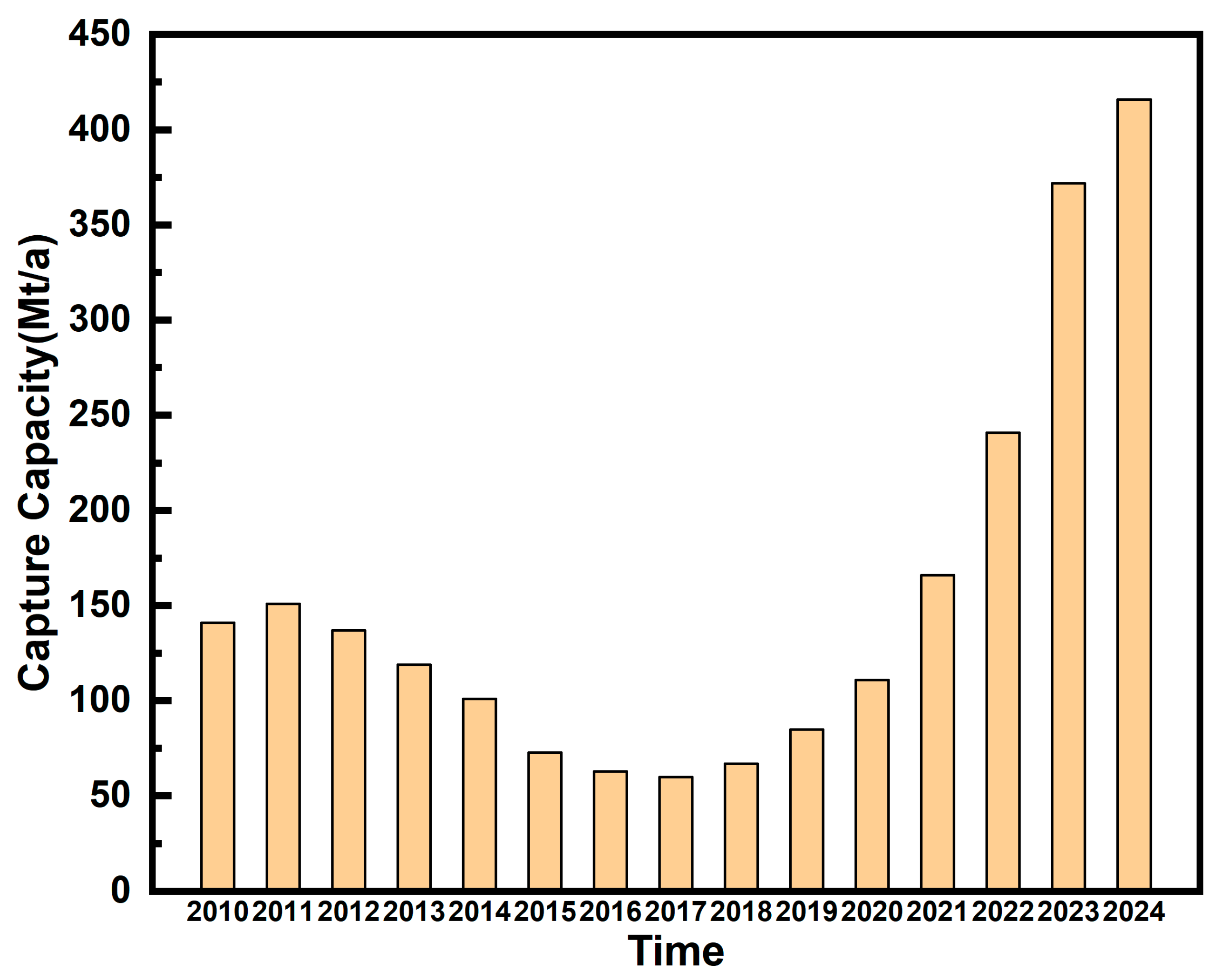
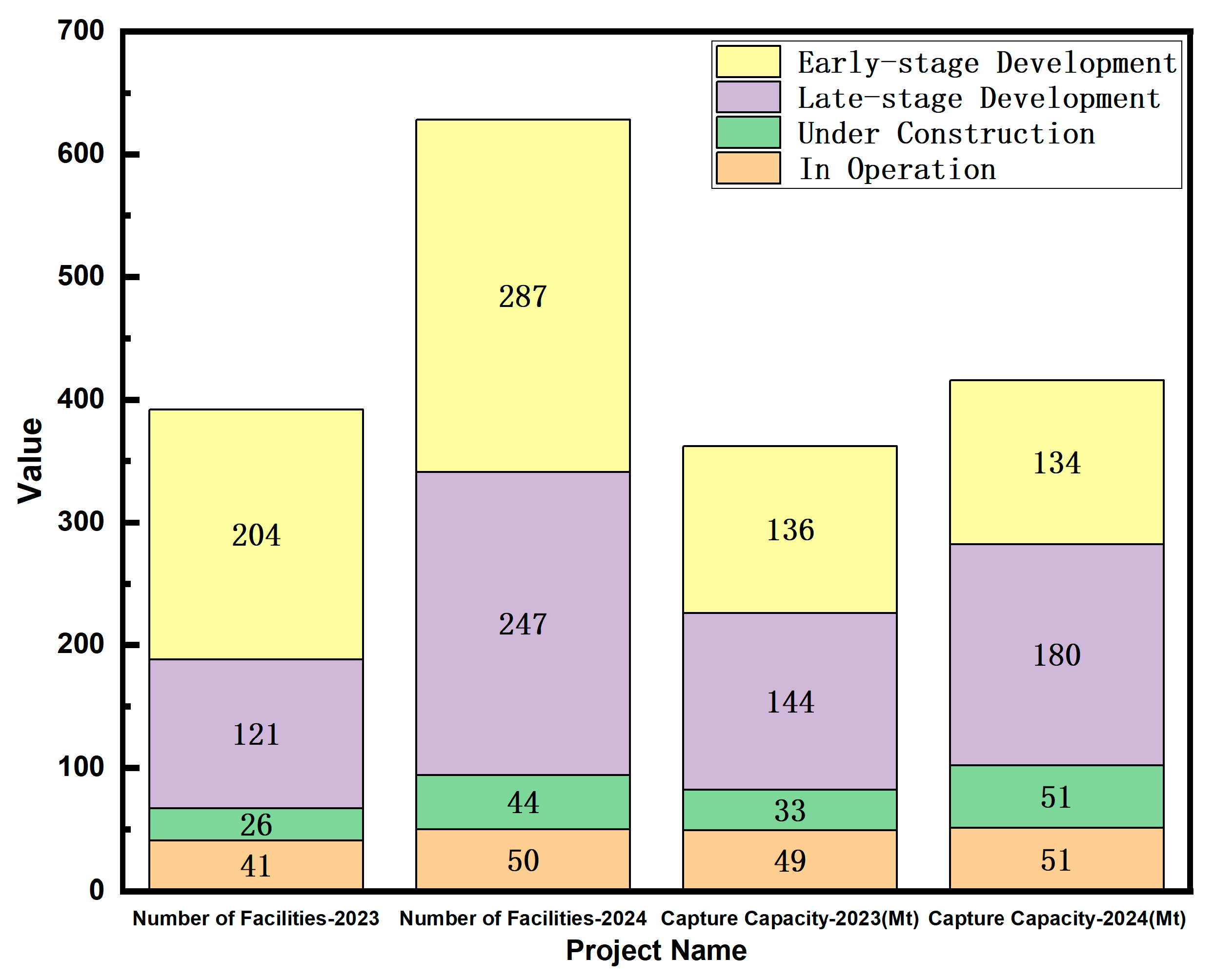
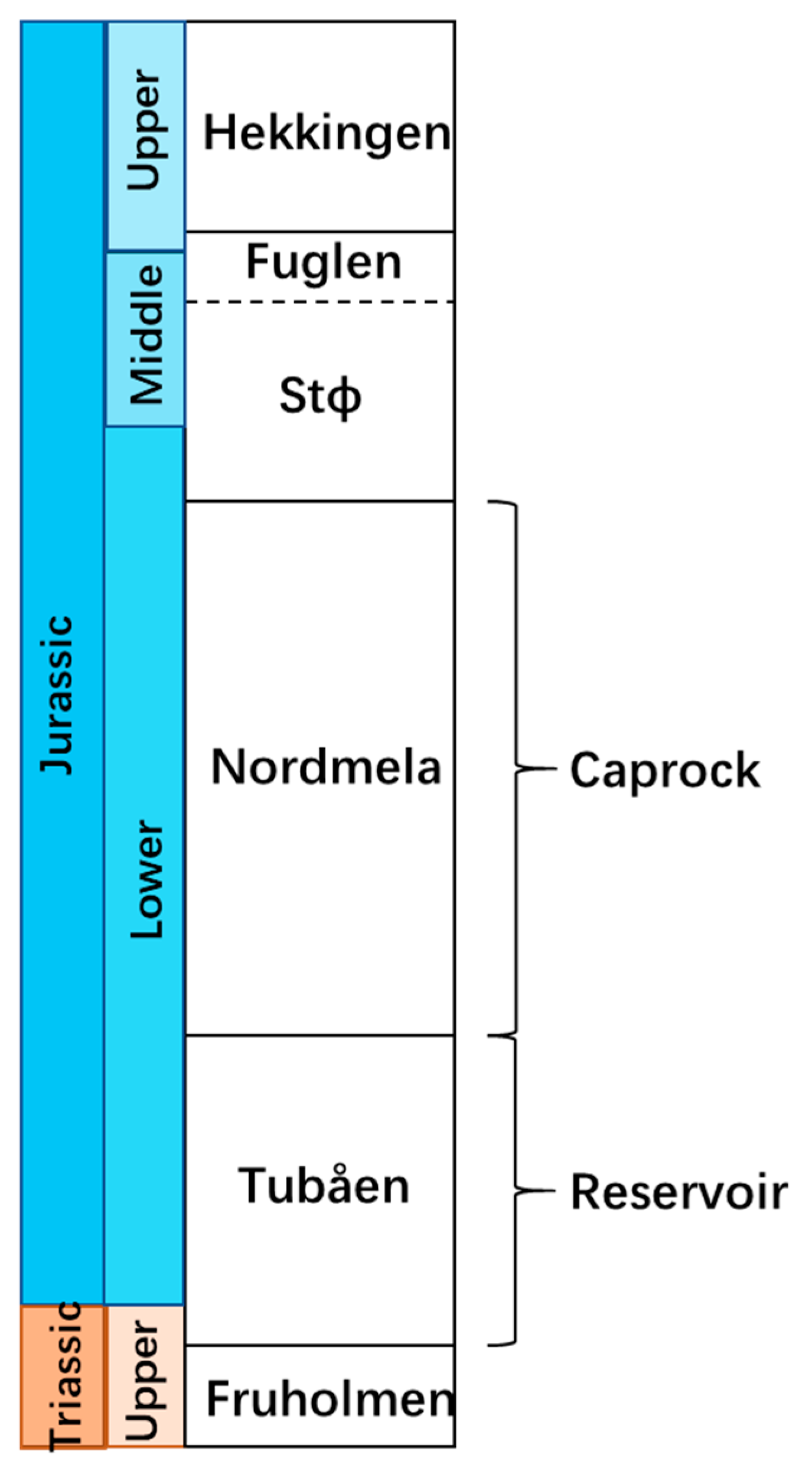
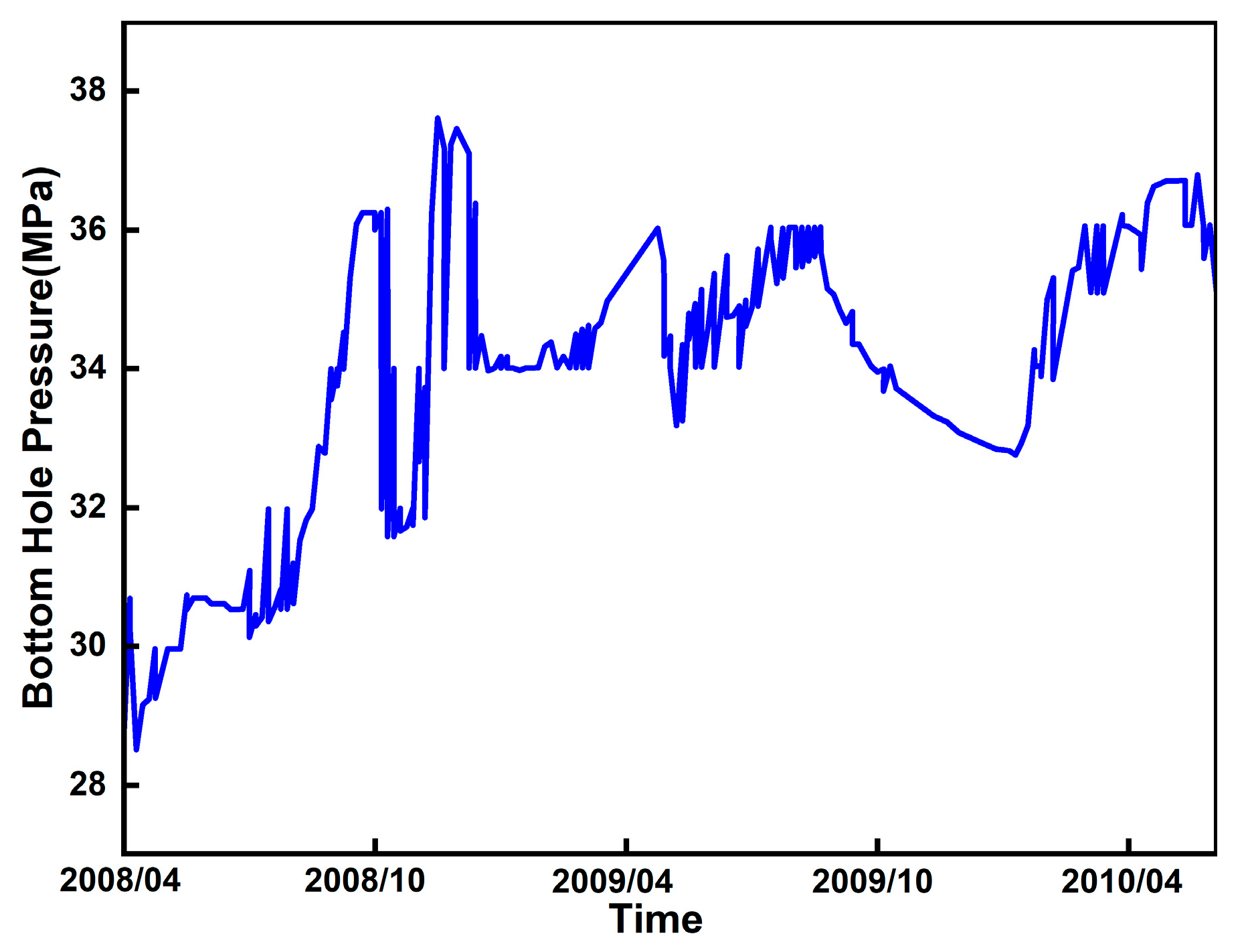
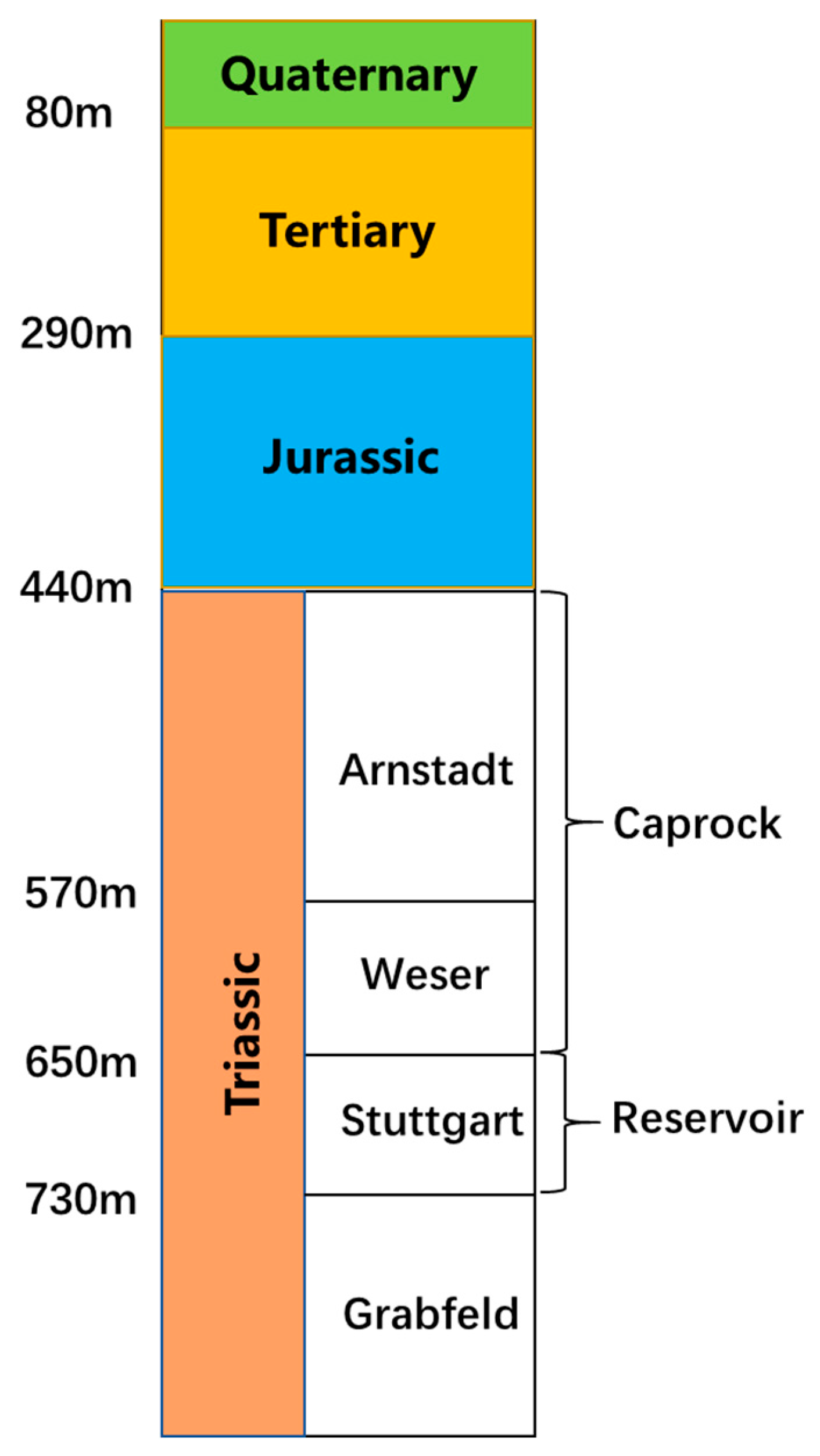



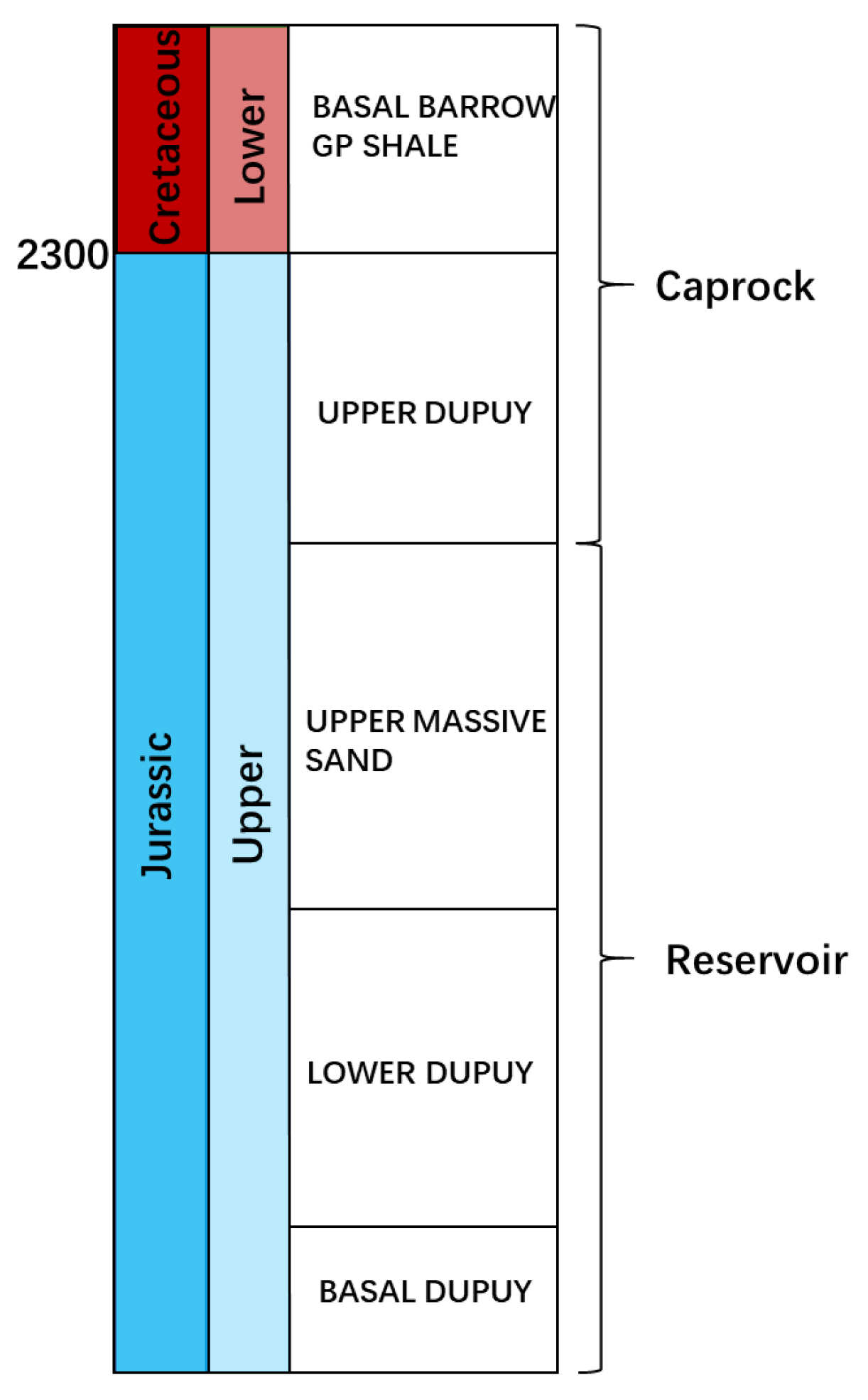
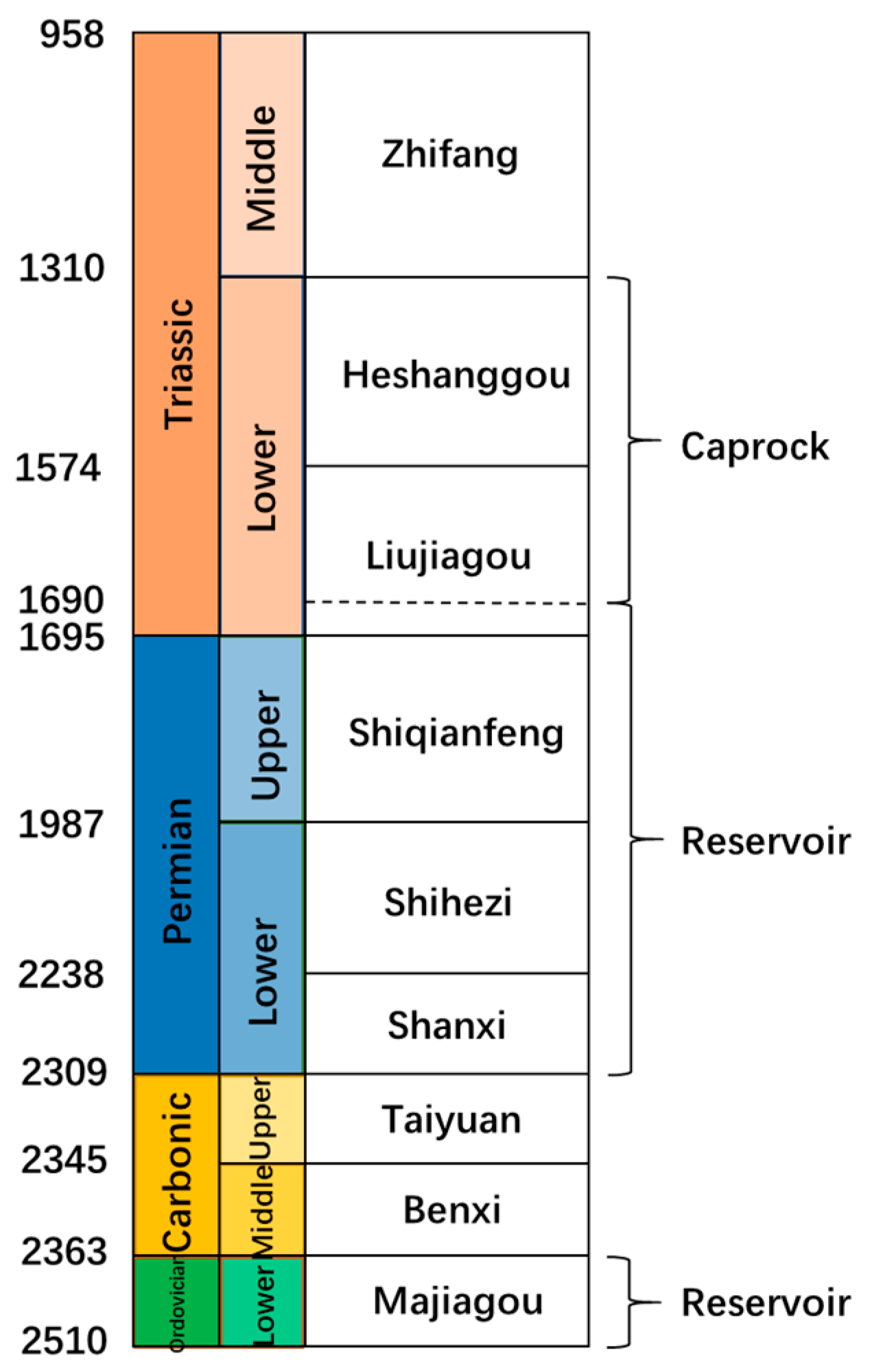
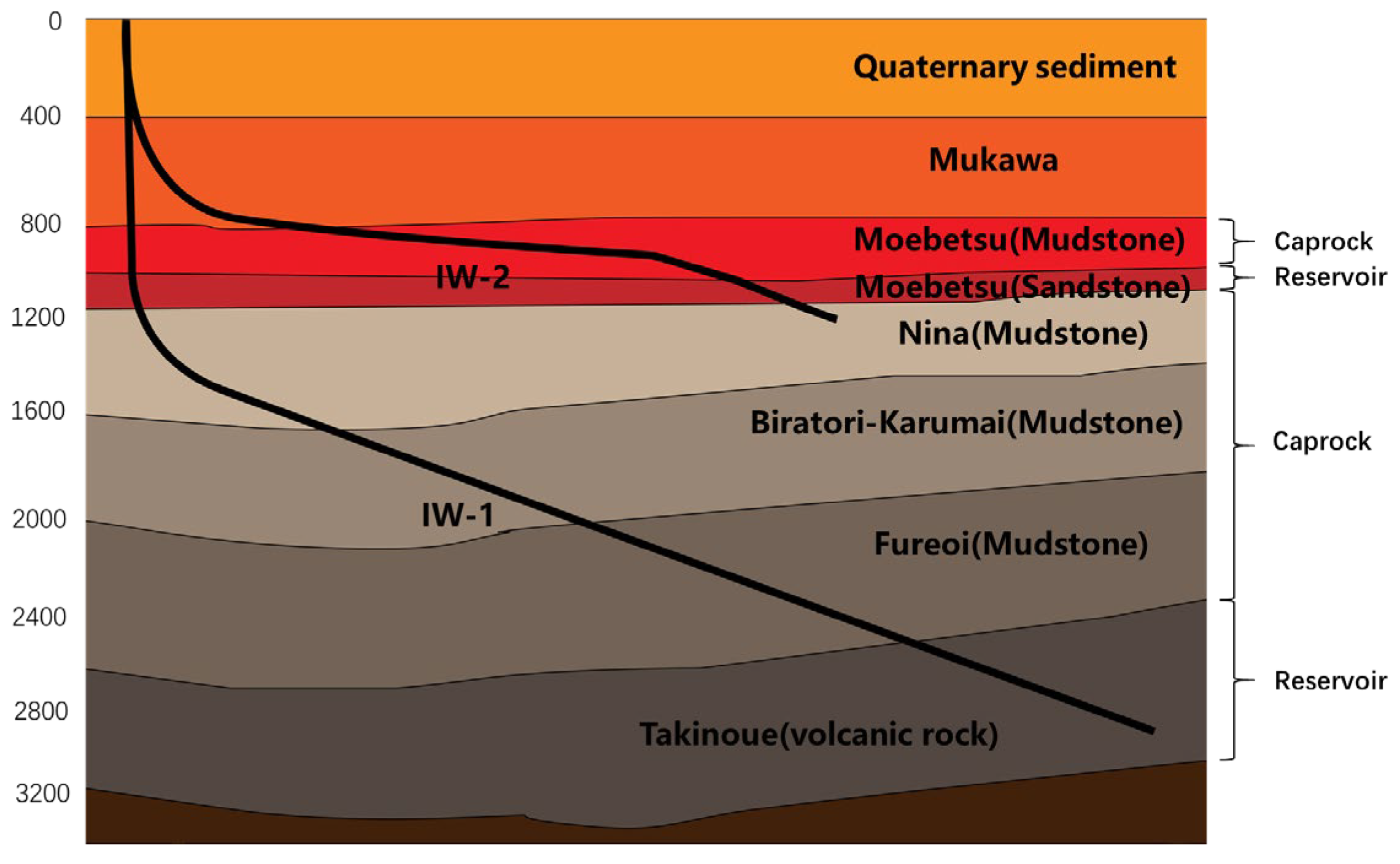
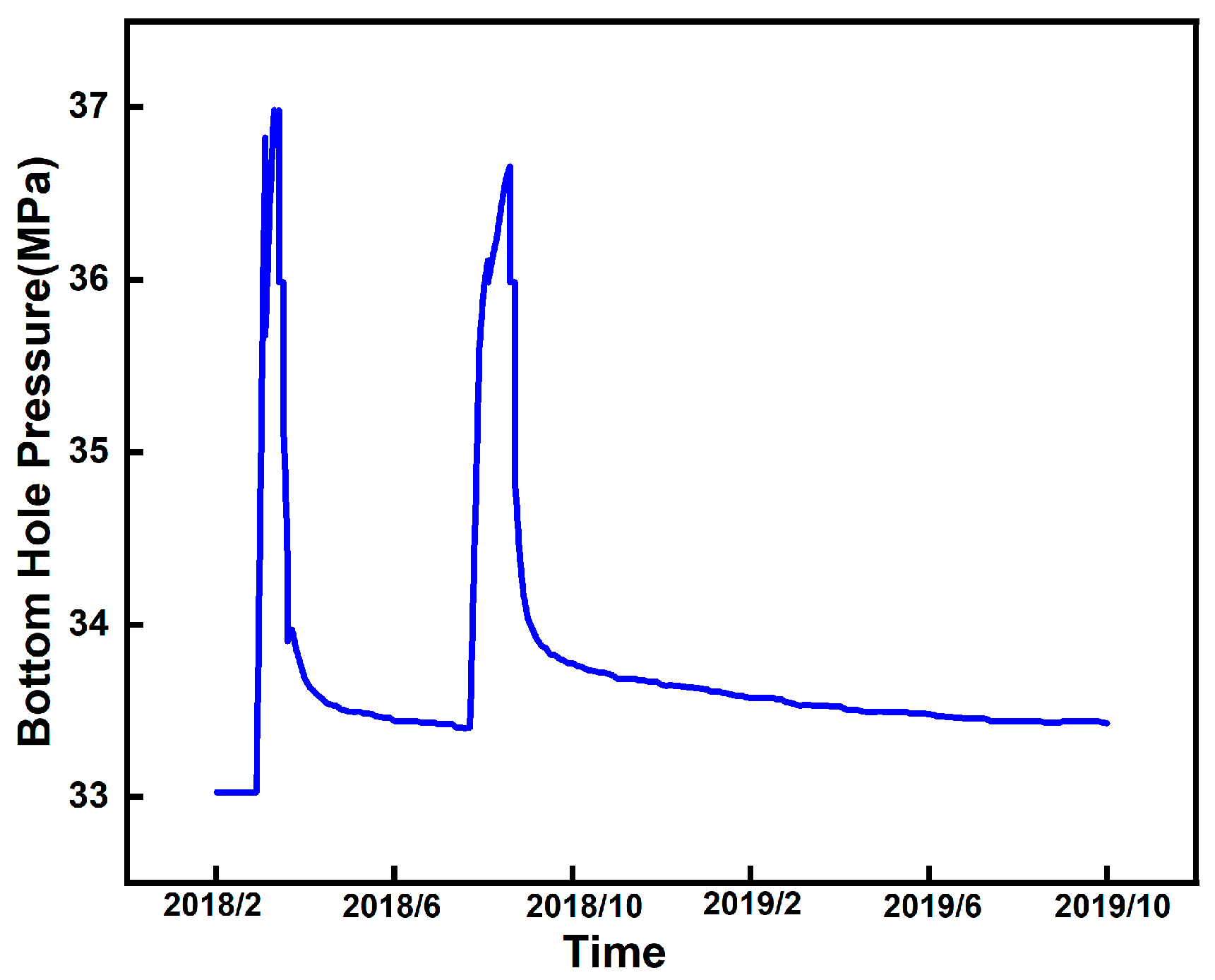
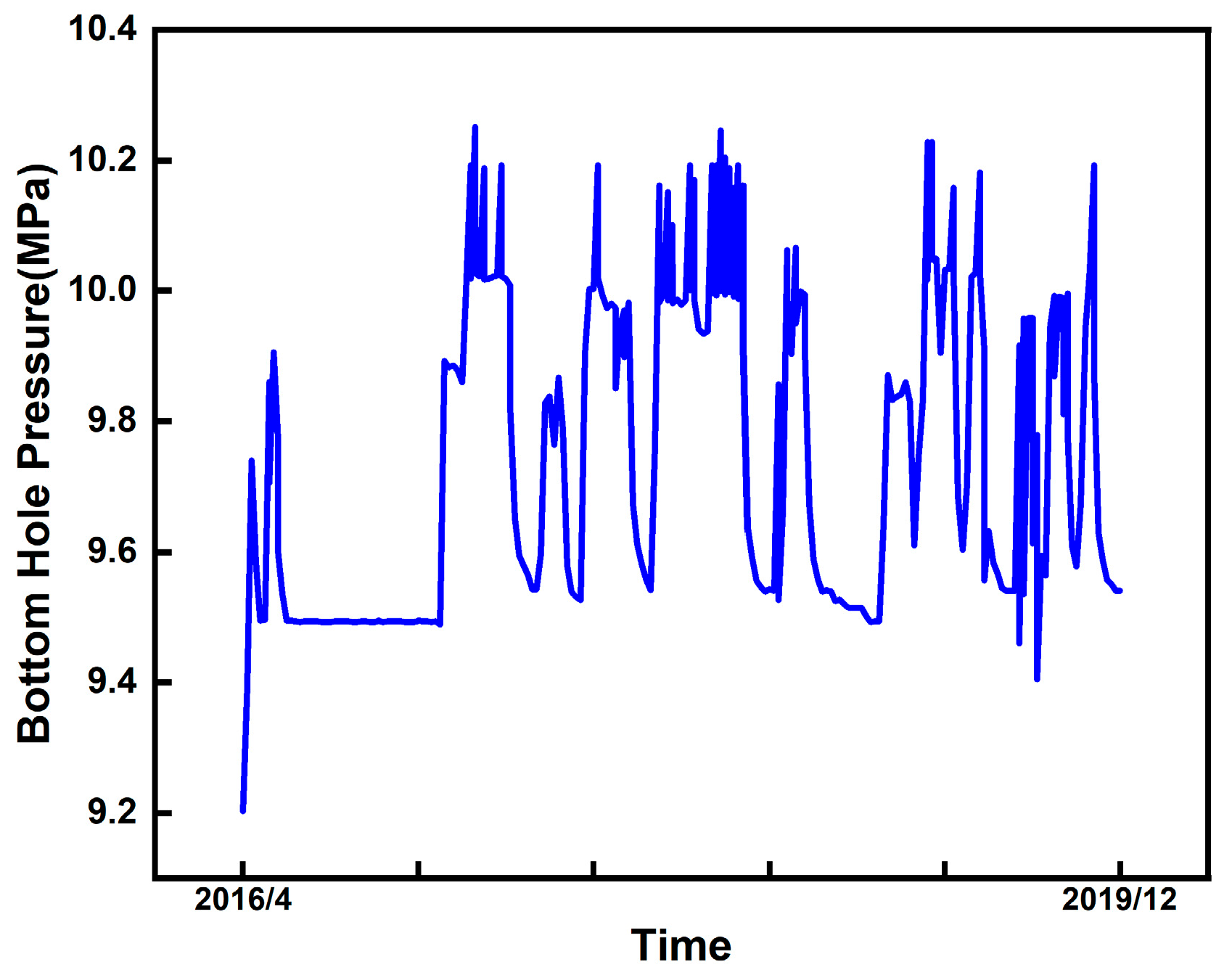


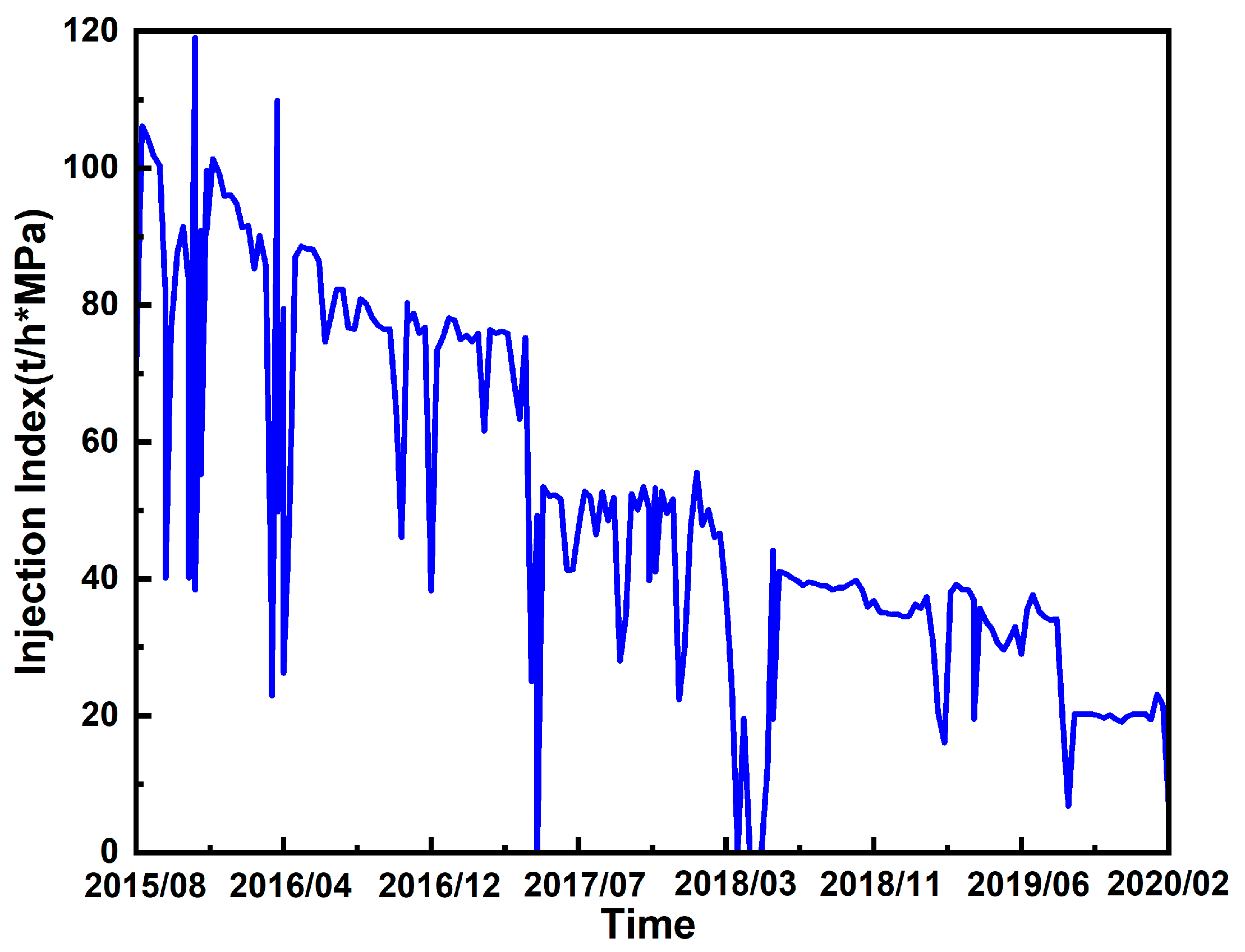
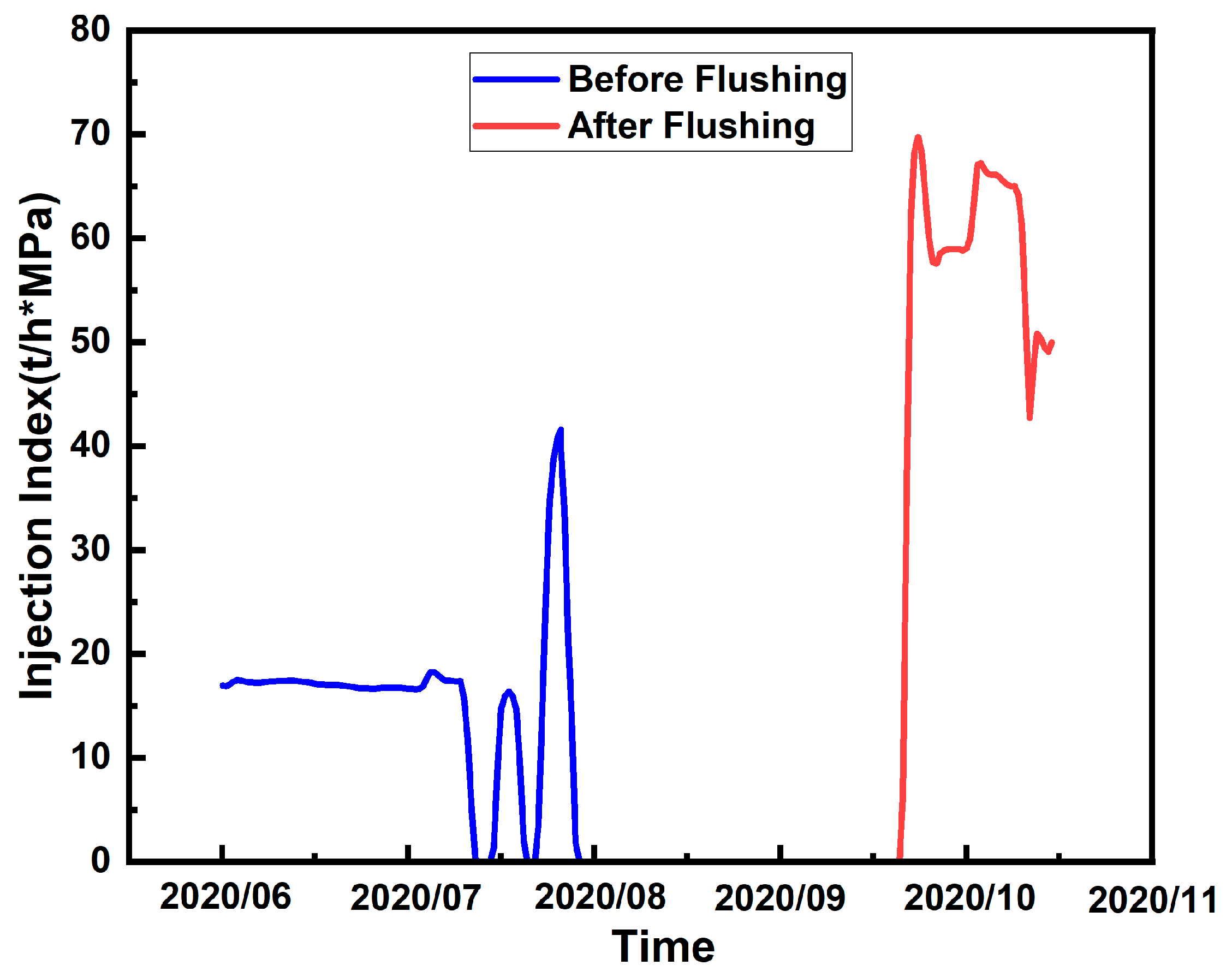
| Area | In Operation | Under Construction | Late-Stage Development | Early-Stage Development | Total |
|---|---|---|---|---|---|
| Americas | 27 | 18 | 146 | 145 | 337 |
| Europe | 5 | 10 | 75 | 105 | 195 |
| Asia | 17 | 14 | 21 | 25 | 77 |
| Oceania | 1 | 2 | 5 | 9 | 17 |
| Africa | 0 | 0 | 0 | 3 | 3 |
| Total | 50 | 44 | 247 | 287 | 628 |
| Project | Temperature (°C) | Pressure (MPa) | Depth (m) | Thickness (m) | Porosity (%) | Permeability (mD) | Salinity (mg/L) | Lithology | Geological Characteristics |
|---|---|---|---|---|---|---|---|---|---|
| Sleipner | 37 | 10.3 | 800–1000 | 250 | 37 | 1000–8000 | 3.5 × 104 | Sandstone | Large-scale anticline structure; faults are not developed |
| Snϕhvit | 98 | 28.5 | 2600 | 45–130 | 1–16 | 130–880 | 1.6 × 105 | Sandstone | Fault-block structure; faults are developed |
| Carbfix | 30–55 | / | 400–800 | 400 | 8.76 | Vertical: 1700 Horizontal: 300 | / | Basalt | Vertical permeability is significantly higher than horizontal permeability |
| Ketzin | 33 | 6.2 | 630–650 | 20–100 | 2–26 | 0.02–2700 | / | Sandstone, Shale | Anticlinal basin; fault zone is developed at the top |
| In Salah | 90 | 17.9 | 1900 | 20 | 17 | 10–100 | / | Sandstone | Anticline, folds are formed, faults are developed |
| Gorgon | 100 | 22 | 2300 | 200–500 | 20 | 25 | 7 × 103 | Sandstone, Siltstone | Anticline |
| Shenhua | / | / | 1690–2450 | 877 | 5–12.9 | 0.1–6.58 | / | Sandstone, Dolomite | Cratonic Basin, gentle structure, monoclinal structure, faults are not developed |
| Enping 15-1 | 52.4 | 8 | 800–900 | 50 | 26 | 2997 | / | / | Good regional connectivity, injection will not form local high pressure |
| Tomakomai | Shallow Layer: 44.8 Deep Layer: 91 | Shallow Layer: 10.67 Deep Layer: 34.37 | Shallow Layer: 1000 Deep Layer: 2400 | Shallow Layer: 200 Deep Layer: 600 | Shallow Layer: 20–40 Deep Layer: 3–19 | Shallow Layer: 9–25 Deep Layer: 0.01 mD–2.6 D | Deep Layer: 1.8 × 104 | Shallow Layer: Sandstone Deep Layer: Pyroclastic Rock | Deep Takinoue Formation with poor physical properties, not conducive to injection |
| Nagaoka | 48 | 10.8 | 1100 | 60 (Zone-2) | 22.5 | 7 | / | Sandstone, Siltstone, Conglomerate | / |
| Quest | 60 | / | 2000 | 350 | 17 | 1000 | / | Sandstone, Shale, Salt Rock | Sedimentary Basin |
| Decatur | / | / | 1691–2150 | 459 | 20 | 185 | / | Sandstone | Cratonic Basin, few geological activities, stable structure |
| Wallula | 40 | / | 828–887 | 20 | 10–15 | 40–100, average 70 | / | / | Regional aquifers exist in basalt, providing a suitable environment for sequestration |
| Pre-Salt | / | / | Over 5000 | / | / | / | / | Lacustrine Carbonate | Faults are sparsely distributed in the reservoir |
| SACROC | / | / | 2042 | 79 | 7.6 | 19.4 | / | carbonatite | Develop karstification, clastic flow, vuggy and microfractures |
| Project | Depth (m) | Thickness (m) | Porosity (%) | Permeability (mD) | Lithology | Characteristics |
|---|---|---|---|---|---|---|
| Sleipner | / | 200–300 | / | / | Clay Minerals, Partial Silt Minerals | There are thin shale layers in the reservoir |
| Snϕhvit | / | 60–100 | 13 | 1–23 | Shale | There are thin shale layers in the reservoir |
| Ketzin | 440–650 | Weser: 80, Arnstadt: 130 | / | / | Anhydrite Layer, Mudstone, Carbonate Rock | Two composite strata |
| Carbfix | / | / | / | / | Pyroclastic Rock | / |
| In Salah | 800–1800 | 900 | / | / | Mudstone | There are 1–5 m thick thin shale layers in the reservoir |
| Gorgon | 2000 | / | / | / | Shale, Sandstone | There are geological lenses |
| Shenhua | 1310–1690 | 700 | Heshanggou Formation: 2.99, Liujiagou Formation: 11.4 | Heshanggou Formation: 0.25, Liujiagou Formation: 4.5 | Mudstone, Sandstone, Feldspar Rock | / |
| Enping 15-1 | / | 180 | / | 0.0004 | Argillaceous | / |
| Tomakomai | / | Shallow Layer: 200 Deep Layer: 1100 | / | / | Mudstone | / |
| Nagaoka | / | / | / | / | Argillaceous Shale | Pleistocene Neritic facies |
| Quest | / | 300 | / | / | / | / |
| Decatur | 1539 | 151 | 3–4 | Less than 0.001 | Shale, Silty Mudstone, Siltstone, Carbonate Rock | / |
| Wallula | / | / | Not exceeding 0.5 | 10−6–10−2 | Low-Permeability Sedimentary Rock and Basalt | / |
| Pre-Salt | / | 2000 | / | / | Evaporite | The continuity and high-plasticity characteristics of salt rock enable it to inhibit fracture development |
| SACROC | / | 150 | / | <0.05 | Shale | / |
| Projects | Monitoring Methods | Spatial Location | Content Classification |
|---|---|---|---|
| Sleipner | 3D/4D Seismic | Deep | Migration |
| Gravity Monitoring | Deep | Migration | |
| Weuburn | VSP | Deep | Migration |
| Microseismic | Deep | Migration | |
| Soil Flux | Surface | Leakage | |
| Groundwater Sampling | Surface | Leakage | |
| In Salah | InSAR | Surface | Leakage |
| Time-lapse Seismic | Deep | Migration | |
| Ssotope Tracer | Surface | Leakage | |
| Soil Gas Analysis | Surface | Leakage | |
| Ketzin | Cross-Hole Resistivity | Deep | Leakage |
| Downhole Temperature and Pressure | Deep | Leakage | |
| Microorganism | Surface | Leakage | |
| Tomakomai | Permanent Subsea Cable | Surface | Leakage |
| Ocean-Bottom Seismometer | Deep | Migration | |
| Shenhua | Atmospheric Eddy Covariance Monitoring | Atmosphere | Leakage |
| SF6 Tracer | Surface | Leakage | |
| Radar Deformation Monitoring | Surface | Leakage |
Disclaimer/Publisher’s Note: The statements, opinions and data contained in all publications are solely those of the individual author(s) and contributor(s) and not of MDPI and/or the editor(s). MDPI and/or the editor(s) disclaim responsibility for any injury to people or property resulting from any ideas, methods, instructions or products referred to in the content. |
© 2025 by the authors. Licensee MDPI, Basel, Switzerland. This article is an open access article distributed under the terms and conditions of the Creative Commons Attribution (CC BY) license (https://creativecommons.org/licenses/by/4.0/).
Share and Cite
Lian, W.; Liu, H.; Li, J.; Wu, Y. Site and Formation Selection for CO2 Geological Sequestration: Research Progress and Case Analyses. Appl. Sci. 2025, 15, 11402. https://doi.org/10.3390/app152111402
Lian W, Liu H, Li J, Wu Y. Site and Formation Selection for CO2 Geological Sequestration: Research Progress and Case Analyses. Applied Sciences. 2025; 15(21):11402. https://doi.org/10.3390/app152111402
Chicago/Turabian StyleLian, Wei, Hangyu Liu, Jun Li, and Yanxian Wu. 2025. "Site and Formation Selection for CO2 Geological Sequestration: Research Progress and Case Analyses" Applied Sciences 15, no. 21: 11402. https://doi.org/10.3390/app152111402
APA StyleLian, W., Liu, H., Li, J., & Wu, Y. (2025). Site and Formation Selection for CO2 Geological Sequestration: Research Progress and Case Analyses. Applied Sciences, 15(21), 11402. https://doi.org/10.3390/app152111402






